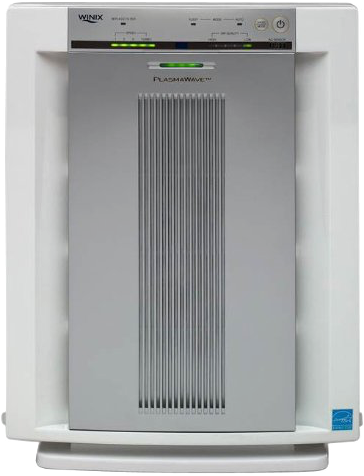
Air cleaners are simple devices: they have a fan that sucks air through a filter; the cleaned air goes back into the room. There’s also, obviously, a switch, but the switch does more than turn the thing on and off. You also want to be able to control the speed of the motor. Faster is louder but cleans the air more quickly. Slower is not so loud, but takes longer to clean the air. That’s all there is to it: a fan, a filter, and a switch.
How could anybody screw up something so simple? Well, the geniuses at Winix have succeeded where lesser minds have failed: they have managed to make a simple device too complicated to use properly. The problem is in the control panel along the top:

(I have doctored this image slightly to make it easier to read.)
It’s pretty obvious that the button on the extreme right is the power button. The button immediately to its left apparently controls the speed and mode. If you press that button repeatedly, it increases the speed of the motor. When the motor is at full speed, another button press changes the mode from AUTO to SLEEP. One might think that SLEEP means that the machine goes to sleep — shuts down temporarily, just like a computer goes to sleep. But no! SLEEP means that you, the user, want to sleep, and it will dim its LEDs. Inasmuch as the LEDs aren’t very bright to start with, this really doesn’t amount to much, but hey, it’s a “feature” that we can use to sell more units!
But the true problem with this design lies on the lower right: the display panel called “Air Quality”. Note that it is a mirror image of the display on the lower left, showing the speed. Obviously, if you control the speed by pressing the SPEED/MODE button continuously, then you can control the air quality by pressing something. But what? Do you double-click on the SPEED/MODE button? Triple-click? Hit it with a hammer?
It turns out that the “Air Quality” display is only that: a display, not a control. You can’t control the air quality. This serves only to tell you how clean your air is. My friend who purchased this expensive air cleaner wasted a lot of time trying to figure out how to get it to improve the air quality.
Which brings us to the next design blunder: the label “Air Quality” is backwards! When “Air Quality” is low, that means that your air is very clean. When “Air Quality” is high, that means that your air is dirty.
My guess is that this thing was built in China, and they directly translated the Chinese labels, only the translator got it backwards.
This has got to be one of the worst designs I have encountered in a long time.
